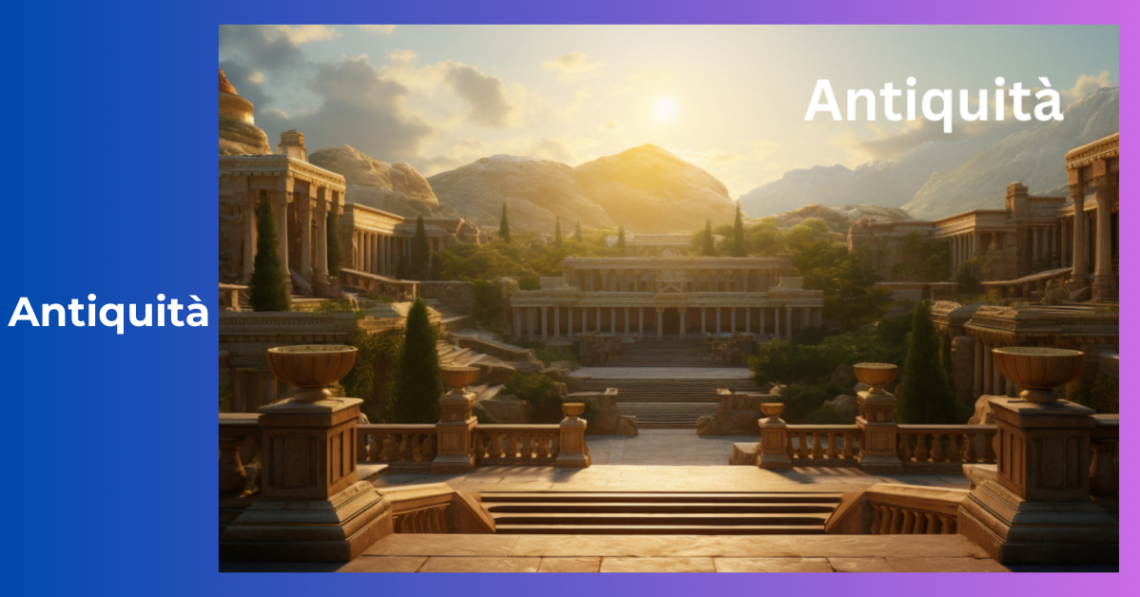
Antiquità _ A Journey Through Ancient Treasures and History
Antiquità, the Italian word for antiquity, represents a world filled with ancient treasures, rich history, and remarkable stories.
“Kw, which translates to ‘antiquity’ in Italian, evokes a realm of ancient treasures, profound history, and captivating narratives.”
This article takes you on a comprehensive journey through the fascinating world of antiquità, exploring its significance, the types of artifacts it encompasses, and its impact on modern society.
Whether you’re a history enthusiast or simply curious about ancient times, this article aims to provide unique insights and analyses that go beyond existing sources.
Understanding Antiquità
What is Antiquità?
Antiquità refers to objects, artifacts, and works of art from ancient times. These items often have historical, cultural, or aesthetic value and are typically from civilizations such as Ancient Egypt, Greece, Rome, and Mesopotamia. The term can also encompass medieval artifacts and those from other ancient cultures around the world.
The Importance of Antiquità
The significance of antiquità lies in its ability to provide a tangible connection to the past. These artifacts offer insights into the daily lives, beliefs, and achievements of ancient civilizations.
They help historians, archaeologists, and scholars understand how these societies functioned and evolved over time.
The Origin of Antiquità
The concept of antiquità originated in the Renaissance period when there was a renewed interest in the classical antiquities of Greece and Rome.
Scholars and collectors sought to rediscover and preserve the art, literature, and artifacts of ancient civilizations, believing them to be the pinnacle of human achievement.
Etymology of the Term
The word “antiquità” is derived from the Latin “antiquitas,” which means “ancient times” or “antiquity.”
It reflects the reverence and admiration for the ancient past that was prevalent during the Renaissance and continues to influence our appreciation of historical artifacts today.
Types of Antiquità Artifacts
Art and Sculpture
Ancient art and sculpture are some of the most celebrated forms of antiquità.
These include statues, reliefs, and frescoes that adorned temples, public spaces, and private homes.
Famous examples include the statues of Greek gods and goddesses, Roman busts, and Egyptian hieroglyphic carvings.
Notable Examples:
- The Venus de Milo, an ancient Greek statue.
- The Colossus of Rhodes, one of the Seven Wonders of the Ancient World.
- Egyptian obelisks, such as Cleopatra’s Needle.
Pottery and Ceramics
Pottery and ceramics are common antiquità artifacts. These items range from everyday household objects to intricately designed ceremonial pieces.
Ancient Greek vases, Roman amphorae, and Chinese porcelain are notable examples.
Significant Pieces:
- The Dipylon Amphora, a large Greek vase used as a grave marker.
- The Terra Sigillata, a type of Roman red pottery known for its glossy finish.
- Ming Dynasty porcelain, highly valued for its quality and beauty.
Coins and Currency
Ancient coins and currency provide valuable information about the economies, rulers, and cultures of the past.
They often feature images of leaders, deities, and symbols that reflect the values and achievements of their time.
Historical Coins:
- The Athenian tetradrachm, featuring the owl of Athena.
- Roman denarii, which often depicted emperors and deities.
- Chinese cash coins, used throughout various dynasties.
Jewelry and Personal Adornments
Jewelry and personal adornments from ancient times include items such as necklaces, rings, bracelets, and earrings.
These pieces were often made from precious metals and stones, reflecting the wealth and status of their owners.
Noteworthy Items:
- The Gold Mask of Agamemnon, a funerary mask from Mycenae.
- Egyptian amulets, believed to have protective properties.
- Etruscan gold jewelry, known for its intricate designs.
Tools and Weapons
Tools and weapons are crucial for understanding the technological advancements and warfare practices of ancient civilizations.
These artifacts include everything from simple stone tools to sophisticated metal weapons and armor.
Key Examples:
- Bronze Age swords, such as those from the Mycenaean civilization.
- Roman gladius, the standard short sword of Roman legions.
- Ancient Chinese crossbows, an early form of ranged weaponry.
Textiles and Clothing
Textiles and clothing offer insights into the fashion, daily life, and social structures of ancient societies.
These artifacts can include garments, fabrics, and accessories preserved through special conditions.
Remarkable Finds:
- The Tarim mummies’ clothing, remarkably well-preserved in the arid conditions of the Tarim Basin.
- Roman togas and tunics, reflecting social status and citizenship.
- Ancient Egyptian linen, often used in mummification.
The Discovery and Preservation of Antiquità
Archaeological Excavations
Archaeological excavations are the primary method for discovering antiquità.
These digs involve carefully unearthing artifacts from historical sites, often buried for centuries.
Famous archaeological sites include Pompeii in Italy, the Pyramids of Giza in Egypt, and the Acropolis in Greece.
Preservation Techniques
Preserving antiquità involves various techniques to prevent deterioration and damage.
These methods include controlled environments, restoration processes, and the use of advanced technology to stabilize and repair artifacts.
Preservation Methods:
- Climate control to prevent damage from humidity and temperature fluctuations.
- Chemical treatments to halt the deterioration of organic materials.
- Digital documentation and 3D scanning to create accurate records of artifacts.
Museums and Collections
Museums play a crucial role in the preservation and display of antiquità.
Institutions such as the British Museum, the Louvre, and the Metropolitan Museum of Art house extensive collections of ancient artifacts, making them accessible to the public and researchers.
Renowned Museums:
- The British Museum in London, with its vast collection of artifacts from around the world.
- The Louvre in Paris, home to iconic pieces like the Mona Lisa and the Venus de Milo.
- The Metropolitan Museum of Art in New York, which has extensive collections from ancient Egypt, Greece, and Rome.
The Impact of Antiquità on Modern Society
Educational Value
Antiquità provides significant educational value, offering insights into the history, culture, and achievements of ancient civilizations.
Schools, universities, and educational programs often incorporate the study of ancient artifacts into their curricula.
Educational Programs:
- University courses in archaeology, history, and art history often feature antiquità studies.
- Museum educational programs and workshops for students and adults.
- Online courses and virtual tours of ancient sites and museum collections.
Cultural Heritage
Antiquità represents a shared cultural heritage that connects people across time and space.
These artifacts remind us of our common human history and the achievements of past civilizations.
Cultural Significance:
- National pride and identity often tied to ancient heritage.
- Cultural festivals and events celebrating historical achievements.
- Preservation efforts to maintain and restore ancient sites and artifacts.
Inspiration for Art and Design
Ancient art and design continue to inspire modern artists, architects, and designers.
Elements of antiquità can be seen in contemporary art, fashion, and architecture, reflecting a timeless aesthetic appeal.
Modern Influences:
- Neoclassical architecture, drawing from ancient Greek and Roman designs.
- Fashion trends inspired by ancient clothing styles and jewelry.
- Contemporary art that references or reinterprets ancient themes and motifs.
Economic and Tourism Benefits
The discovery and display of antiquità can have significant economic benefits, attracting tourists and generating revenue for local economies.
Historical sites and museums draw millions of visitors each year, contributing to the preservation and promotion of cultural heritage.
Tourism Impact:
- Increased tourism to countries with rich ancient histories, such as Italy, Greece, and Egypt.
- Economic benefits from museum admissions, guided tours, and related hospitality services.
- Job creation in the fields of archaeology, conservation, and museum management.
Controversies and Ethical Considerations
Looting and Illegal Trade
Looting and illegal trade of antiquità are major issues, leading to the loss of valuable artifacts and cultural heritage.
Efforts to combat these activities include international agreements, stricter laws, and increased cooperation between countries.
Combatting Looting:
- The 1970 UNESCO Convention aimed at preventing the illicit trade of cultural property.
- National and international law enforcement agencies working to recover stolen artifacts.
- Public awareness campaigns highlighting the importance of protecting cultural heritage.
Repatriation of Artifacts
The repatriation of artifacts involves returning antiquità to their countries of origin. This issue often arises when artifacts have been taken or sold under questionable circumstances.
Recent examples include the return of the Elgin Marbles to Greece and the repatriation of Native American artifacts to their respective tribes.
Repatriation Efforts:
- Negotiations between countries and museums for the return of cultural heritage items.
- Legal battles over the rightful ownership of ancient artifacts.
- Successful repatriation cases that serve as models for future efforts.
Authenticity and Forgery
Ensuring the authenticity of antiquità is a critical concern. The market for ancient artifacts is susceptible to forgeries and counterfeit items.
Advances in scientific analysis and provenance research help verify the authenticity of artifacts.
Authenticity Measures:
- Scientific techniques such as radiocarbon dating, thermoluminescence, and DNA analysis.
- Provenance research to trace the history and ownership of artifacts.
- Expert assessments and certifications to confirm authenticity.
The Future of Antiquità
Advances in Technology
Technology continues to revolutionize the study and preservation of antiquità.
From 3D scanning and printing to advanced imaging techniques, new tools are helping researchers uncover more about ancient artifacts and ensure their longevity.
Technological Innovations:
- 3D printing used to create accurate replicas of fragile artifacts for study and display.
- Digital reconstruction of ancient sites and artifacts, providing immersive educational experiences.
- Advanced imaging techniques revealing hidden details and inscriptions.
Public Engagement and Education
Increasing public engagement and education about antiquità is essential for its preservation and appreciation.
Interactive exhibits, virtual tours, and educational programs are helping to bring the ancient world to a broader audience.
Engagement Strategies:
- Interactive exhibits that allow visitors to experience ancient artifacts in new ways.
- Virtual reality tours of archaeological sites and museum collections.
- Educational initiatives targeting schools, communities, and online learners.
Ethical Collecting and Ownership
The future of antiquità also involves addressing ethical considerations around collecting and ownership.
Ensuring that artifacts are acquired, displayed, and repatriated ethically is crucial for maintaining the integrity of cultural heritage.
Ethical Practices:
- Transparent acquisition processes for museums and collectors.
- Collaboration with source countries and communities to ensure respectful handling of artifacts.
- Ongoing dialogue about the ethical implications of artifact ownership and display.
Conclusion
Antiquità offers a captivating glimpse into the past, connecting us with the rich history and remarkable stories of ancient civilizations.
By exploring various types of artifacts, understanding their significance, and addressing the ethical considerations surrounding their preservation, we can appreciate the value of antiquità in our modern world.
This comprehensive journey through antiquità not only highlights its importance but also inspires us to preserve and cherish these ancient treasures for future generations.
FAQs About Antiquità
What is the meaning of antiquità?
Antiquità is the Italian word for antiquity, referring to ancient artifacts, objects, and works of art from past civilizations.
Why is antiquità important?
Antiquità is important because it provides a tangible connection to the past, offering insights into the history, culture, and achievements of ancient civilizations.
How are antiquità artifacts discovered?
Antiquità artifacts are typically discovered through archaeological excavations, where experts carefully unearth items from historical sites.
What are some famous examples of antiquità?
Famous examples of antiquità include the statues of Greek gods and goddesses, Roman busts, Egyptian hieroglyphic carvings, and ancient Greek vases.
How are antiquità artifacts preserved?
Antiquità artifacts are preserved using controlled environments, restoration processes, and advanced technology to prevent deterioration and damage.
Why is the repatriation of artifacts important?
The repatriation of artifacts is important to return cultural heritage items to their countries of origin, respecting their historical and cultural significance.
What role do museums play in antiquità?
Museums play a crucial role in preserving, displaying, and educating the public about antiquità. They house extensive collections of ancient artifacts and provide access for researchers and visitors.
How does technology impact the study of antiquità?
Technology has revolutionized the study of antiquità through advanced imaging techniques, 3D scanning, and digital reconstruction, helping researchers uncover new information and preserve artifacts.
What ethical issues surround the collection of antiquità?
Ethical issues include looting, illegal trade, and the rightful ownership of artifacts. Ensuring ethical acquisition, display, and repatriation of antiquità is crucial for maintaining cultural heritage.
How can the public engage with antiquità?
The public can engage with antiquità through museum visits, virtual tours, educational programs, and interactive exhibits that provide insights into ancient artifacts and their significance.
You May Also Like

Luther Editor, Social Media Maven, Keezy.co: A Comprehensive Guide
July 18, 2024
Vy6ys _ Ultimate Mood Board and Inspiration Gallery
July 18, 2024

